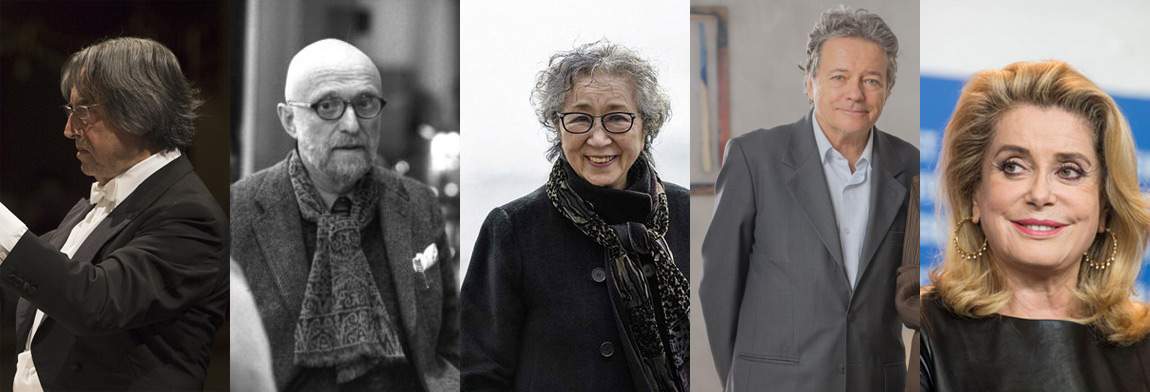The Praemium Imperiale 2018 to Riccardo Muti and Pierre Alechinsky. Here are all the winners
Pierre Alechinsky for painting, Fujiko Nakaya for sculpture, Riccardo Muti for music, Christian de Portzamparc for architecture, and Catherine Deneuve for theater/cinema: they are the winners of the 2018 edition of the Imperial Preaemium, the world’s highest award in the arts. Each of them, chosen for their achievements in the art world, their influence, and their contributions to the world community, will receive a diploma and medal conferred by the honorary patron of the Japan Art Association, Prince Hitachi, at an awards ceremony in Tokyo on Oct. 23, as well as a 15 million yen (about 115,000 euros) prize.
The Praemium Imperiale, now in its 30th year, is the world’s most important art award. It is awarded in five disciplines (painting, sculpture, architecture, music, theater/cinema) and confers international prestige in the arts equal to that of the Nobel Prizes in science. It is also unanimously recognized for its authority because of the extreme rigor of its candidate selections and final choice of winners. In each of the six countries of the International Councilors special committees chaired by them propose nominations for the annual awards. Subsequently, from these “roses” of names the Japan Art Association Selection Committees see to it that the five winners are chosen. The utmost seriousness and the absence of any calculation or conditioning are thus assured. The Praemium Imperiale was founded in 1988 and has awarded 154 artists, including this year’s, since 1989.
Also announced today were the winners of the 2018 Praemium Imperiale Fellowship, which goes to the Shakespeare Schools Foundation (UK). Indeed, ln addition to awarding the Praemium Imperiale in five different categories, the Japan Art Association awards an annual Fellowship to a group or institution that promotes youth participation in the arts. The awarding of the Fellowship is the responsibility of each of the Japan Art Association’s six International Councilors on a rotating basis.
Below are all the motivations for the five winners.
For Painting: Pierre Alechinsky (Brussels, 1927).
Ever since he joined an avant-garde movement in Belgium and Northern Europe some seventy years ago, Pierre Alechinsky has remained true to his passion for painting. Deeply influenced by Japanese calligraphy, which combines tradition and modernity, he has developed his own style-in painting, drawing, printmaking, and ceramics-characterized by vivid colors and energetic brushstrokes. Alechinsky strongly influenced the world of painting in Europe. It arouses admiration that he is still active at the age of ninety.
For Sculpture: Fujiko Nakaya (Sapporo, 1933).
If Isamu Noguchi expanded the genre of sculpture with his “Sculptures of the Earth” and James Turrell did the same with his “Sculptures of Light,” Fujiko Nakaya can be said to have extended that boundary to include “Sculptures of the Atmosphere,” using fog as a medium. For the past 48 years, she has studied and created her “Fog Sculptures” using artificial fog created with pure water, fusing art and technology together. He has created more than 80 works of art around the world. As he increases his environmental awareness, his works as a “Fog Artist” are extremely popular.
For Architecture: Christian de Portzamparc (Casablanca, 1944)
Christian de Portzamparc has profoundly transformed the image of the modern architect, prosaic and pragmatic, with his strong will to create architecture endowed with philosophical and artistic depth. His style differs from the modernism of Le Corbusier. He attaches great importance to the interaction between urban spaces and human beings, an element on which he built his theory of architecture. His efforts to elevate architecture to the highest heights of the academy as a professor at the Collège de France are also highly appreciated.
For Music: Riccardo Muti (Naples, 1941)
With his prestigious achievements as a conductor, Riccardo Muti is considered a “Maestro among Maestros.” He has conducted the world’s leading orchestras. His contribution regarding Verdi’s operas, in particular, is of historic significance. His outstanding project “The Ways of Friendship,” which aspires to unite people of different backgrounds through concerts, has lasted for 20 years and is extremely popular. It is also praiseworthy that he founded the “Italian Opera Academy” to support and train young conductors and opera singers.
For Theater/Cinema: Catherine Deneuve (Paris, 1943)
Incredibly gifted with the ability to express the delicate nuances of feeling, Catherine Deneuve is considered one of the best actresses in the world. She was unanimously voted Best Actress at the Cannes, Venice and Berlin international film festivals. She has tackled unusual roles successfully and fearlessly, and is extremely popular with all kinds of audiences. She has acted in more than a hundred films and continues to this day to prove her acting maturity. In addition, she is always ready to take sides by taking a social stand based on her own convictions.
Pictured are the winners of the 2018 Praemium Imperiale. From left: Riccardo Muti, Pierre Alechinsky, Fujiko Nakaya, Christian de Portzamparc, Catherine Deneuve
 |
| The Praemium Imperiale 2018 to Riccardo Muti and Pierre Alechinsky. Here are all the winners |
Warning: the translation into English of the original Italian article was created using automatic tools. We undertake to review all articles, but we do not guarantee the total absence of inaccuracies in the translation due to the program. You can find the original by clicking on the ITA button. If you find any mistake,please contact us.





























